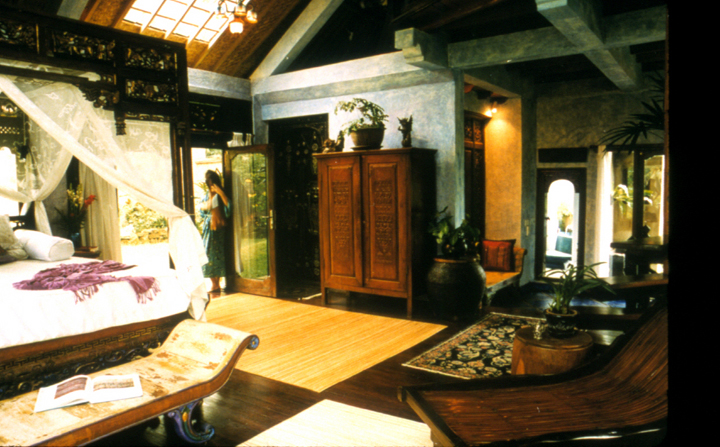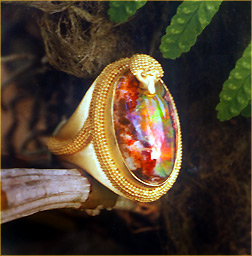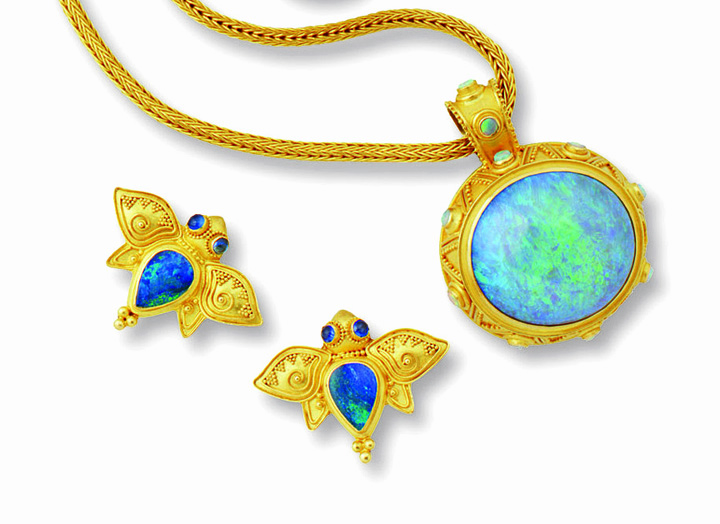Carolyn Tyler wasn’t always known for her jewelry designs. She began her career as a graphic designer and ran an advertising agency, zooming around in her BMW, making deals on her car phone between appointments. When she could find time, she would ride her horse along the surf from her beachside home in Santa Barbara to a shorefront restaurant, listen to a friend sing jazz, then ride home by moonlight.

But after a decade of producing ad campaigns and working 18-hour days, she began to burn out. In 1988, newly divorced, she took off for Asia, stopping off in Bali for a few days. “The airport in Denpasar was just a funky, little Third World airport then, but the minute my foot hit the tarmac, it was as if every cell in my body woke up,” she recalls. “This voice in my head said ‘You’re home.'”
Tyler returned to Bali every year after that. “Bali is like a huge natural playground for the child in me. As a kid I used to pretend I lived in the jungle. I’d throw my mom’s costume jewelry in the pool, get a big abalone shell, dive in and scoop it up. I had a thing for moss, ferns and tropical foliage. I always imagined living in a hobbit land with streams and ponds and frogs. Bali was like my childhood fantasy in living color.”
Finally, after a bad breakup and the death of her mother, she decided to relocate there. She refinanced her house and packed her belongings. But before she left, a jewelry designer friend convinced her to come to the Tucson gem shows. “When I arrived, she was white as a sheet, bags packed, keys in hand,” Tyler recounts. “She said, ‘My mother had a heart attack and I have to leave. Please stay for 10 days and buy my stones.’ She handed me a list and said, ‘You’ll learn. Just spend the first seven days looking. Here are the prices you should pay.’
“By the end of that week, I was completely into gemstones,” Tyler says. “I was addicted.” On top of the stones she bought for her friend, she spent $5000 on gems. A month later, she arrived in Bali with a bag of rocks and no idea how to set them. Fortunately, she had landed on an island inhabited by some of the world’s most skilled – and least expensive – goldsmiths.

Still grieving, she threw herself into manic creativity. By day she worked on her riverside house, then designed jewelry into the wee hours. After a year or so, she had 80 pieces and fellow ex-pat Lee Downey invited her to share his booth at the Tucson Gem Shows. That was the year someone decided to start his own gallery, showed up in Tucson and bought out the entire inventory of 23 designers. His checks bore no address or phone number and a few people ripped theirs up. “But mine cleared within two days – for $67,000,” Tyler says. “I was back in business.”
After that, her jewelry business took off. She formed the pool of goldsmiths that work with her today – about a dozen permanent and another dozen on call, as work flow merits. At one point, she attempted to organize her goldsmiths into a small factory to save on equipment, but found the quality of their work dropped. “They’re much happier working at home with their wives and kids around, and it shows in the jewelry.”
These days, her production system is on autopilot. Tyler does most of her designing after sundown. “That’s when the phone stops ringing and it’s just me. I put on some good, trancey music or some blues or slow jazz. The fireflies are coming in. It’s like a dream. I get out all my stones and spread them on the table.

“Usually I pick a central stone, look at the colors in it, pull out side stones. I just trace the stone and sit there with it, see if it wants to be a pin or a pendant, or both. Usually it’s pretty obvious if it’s a ring or earrings. I love mixing and matching colors, especially combinations like purple and chartreuse or orange and purple – slightly jarring but satisfying.”
Then she weighs the stones, puts them in plastic bags “like TV dinners” with little drawings, carefully labeled with detailed instructions – right down to the proper wire gauges. “It’s all spelled out as much as possible because if I don’t, they will often take liberties with the designs.”
 Her designs reflect her studies of ancient cultures – she has a degree in archaeology and cultural anthropology – and the natural beauty around her. “It isn’t the visual sense of the people in Bali that inspires me, it’s the land itself, the texture of the air, the moisture and the scent, all the flowers. I love the moss on the brick, the beautiful old patina.”
Her designs reflect her studies of ancient cultures – she has a degree in archaeology and cultural anthropology – and the natural beauty around her. “It isn’t the visual sense of the people in Bali that inspires me, it’s the land itself, the texture of the air, the moisture and the scent, all the flowers. I love the moss on the brick, the beautiful old patina.”
“You get a lot of support for being artistic in Bali, but the Balinese are not particularly cut out for free thinking in terms of creativity. They are raised to respect tradition. It’s not in their culture to ‘think outside the box.’ It’s the marriage of Western ingenuity with the Asian attention to detail and perfectionism that creates these crafts we’re all doing over there.”


